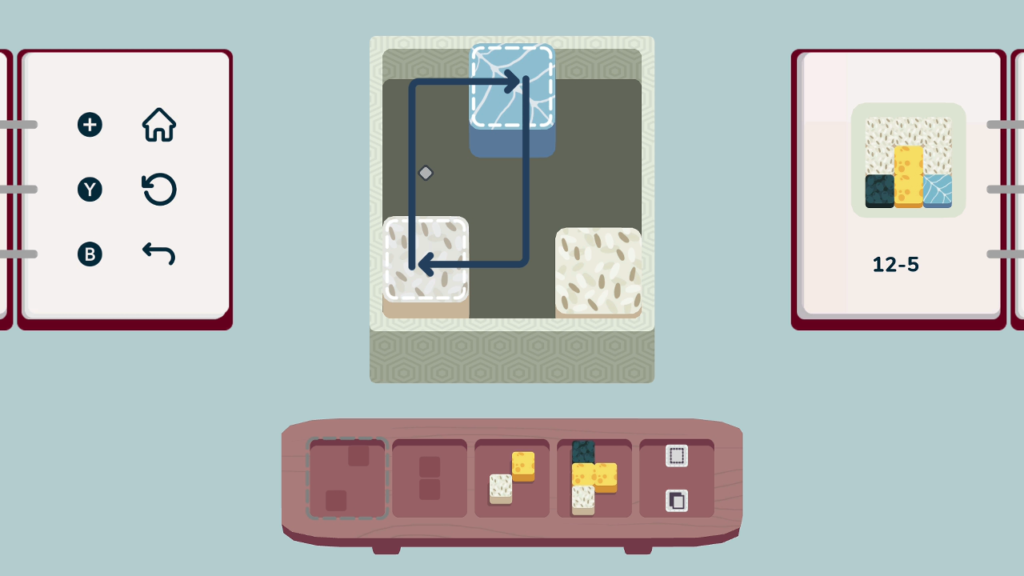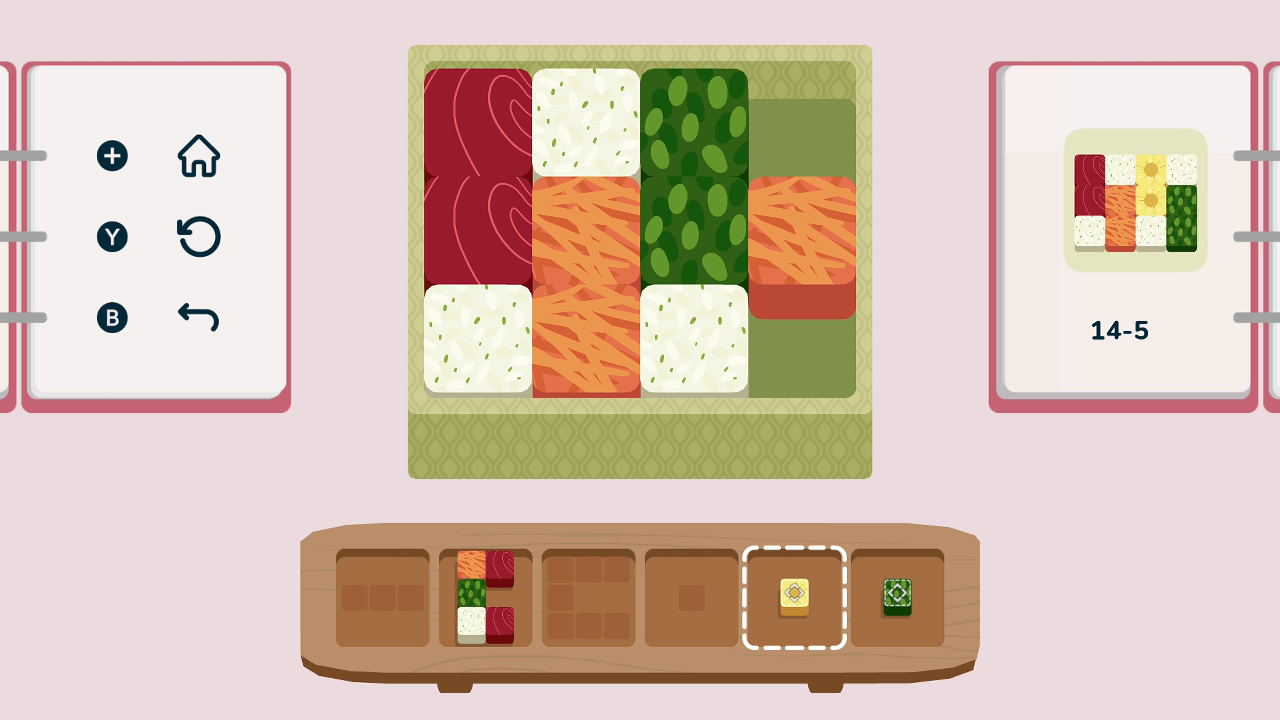inbento is a simple puzzle solving videogame where I manipulate the movable squares in a box so they match the immovable squares in a second box. The squares and boxes in this exercise are dressed up as bento, the Japanese boxed lunch where small portions of food are placed into portable containers, often with dividers to keep each portion separate from its neighbors. inbento focuses in particular on how homemade bento represents family love and care. As I complete over one hundred and twenty unique puzzles, I witness vignettes that show a parent preparing bento for their child and how that small act of compassion steers the child’s future.

Out of a doubtless benevolent desire to ensure I understand its central conceit, inbento’s first puzzle is so simple it’s almost insulting to my intelligence. It consists of an empty square. I see beside it an example of the completed puzzle, with a square of stylized white rice placed in the box. At the bottom of the screen I see the puzzle piece I will use to complete this particular puzzle: a square of stylized white rice. I pick up the rice square with the press of a button, the click of a mouse, or by touching it with my finger—depending on which platform I am playing on—then place it in the box. Puzzle solved.
Subsequent puzzles become a little larger and require dropping multiple pieces into the box to match the example. I soon recognize the deeper nuances of the rules, namely that the number of puzzle pieces is also the number of steps I have to solve the puzzle. I can undo placing a piece, or restart the puzzle from scratch, but if there are three puzzle pieces, then I will solve the puzzle in three steps.

Once I’ve demonstrated I grasp the fundamentals, inbento begins to layer on its complications. Puzzle pieces begin to have two, three, or even more squares in them. I can rotate them to create innumerable possible solutions. After I’ve solved a few rotation-based puzzles, I must begin overlapping pieces when placing them in the box. When a new square is placed over an old one, the older square magically disappears.
All of these puzzles are straightforward, often requiring only a few seconds thought to solve, if even that much. After about twenty puzzles, they become more devious. Instead of only adding new food squares, some puzzle pieces modify the squares already in the box. It is with this evolution that I begin to spend more than a half-glance deducing a puzzle’s solution.

It begins with puzzle pieces that switch the positions of two existing squares. After that are pieces that shift squares around the board, overwriting the square which is moved upon and leaving a blank space where the first square used to be. Next are pieces that allow me to remove squares from the board and replace them wherever I wish, even if it’s several steps later. The trickiest puzzle pieces take their inspiration from Microsoft Paint, letting me copy and paste individual squares, or transform an entire section of the box—“paint”—into another type of square.
At first I encounter these new puzzle piece concepts one at a time. As I progress through the batches, they begin to appear in combination, complicating the possible puzzle solutions and ascending the difficulty at an exponential rate. It takes me about two hours to finish the first two-thirds of inbento’s 127 puzzles. Around puzzle 90 I encounter several individual puzzles that take me up to an hour to solve.

inbento’s pleasant piano-driven soundtrack sets a gentle tone to my efforts. The tempo remains andante at all times, following short melodies made of simple note strings pattering above punctuating chords. The whole soundtrack communicates to me that there’s no rush to finish a puzzle. I should attempt them at a leisurely pace.
When I’m breezing through puzzles, inbento’s simple soundtrack does an admirable job receding unnoticed into the background. It’s when I get stuck on a tricky puzzle that it becomes less effective. The short melodies mutate into a repetitive cacophony, an organ grinder’s tune played on loop in my skull, taunting my consternation with the task in front of me. One melody that plays in the eleventh puzzle batch consists of a set of three ascending notes followed by three descending notes. It plays this melody over and over. This batch contains several puzzles that leave me stuck longest, and those six notes still haunt me as I write this.

Despite sometimes feeling like inbento’s music is taunting me, its repetitiveness does also inspire me to persist with the trial-and-error of puzzle solving. Persistence is key to success. I like to begin puzzles by finding the one big move that will bring the puzzle closest to its conclusion. This is often a good choice. Sometimes it is not and a more roundabout path is the only way of reaching the final puzzle shape. These are the puzzles I get stuck on longest. I struggle to see the broader theory of solving inbento’s puzzles. I solve many through dumb luck. I solve others through sheer brute force of every possible move with the available pieces. I don’t feel like I solve any of them through true understanding of inbento’s mechanics.
The longer I am stuck on a puzzle, the more I am tempted to cheat. The internet is a nearly bottomless informational resource, and with videogames among its most popular topics, it’s not difficult to find answers to questions for even the smallest and most obscure videogames. I don’t like looking up answers on the internet for puzzle videogames. I feel like if I’m going to search for one puzzle solution, I may as well do it for another, and then another, until I’m spending more time checking for solutions instead of understanding the metagame’s theory. inbento doesn’t help me curb this impulse by not offering any kind of hint system; if I’m completely stuck on a puzzle, I won’t find any sympathy from the videogame.

I make a deal with myself: If I cannot solve a puzzle after one solid hour of trying, I can look up the answer… but I will only look at the first step of that answer as a clue to get me started. This strategy keeps me going through all of inbento’s puzzles. In the end, I only look up a hint for about six of them.
inbento is divided into fourteen batches with nine puzzles in each. In between each batch I am treated to a vignette, a single image which shows a child’s growth into adulthood. Bento is an important part of each step of their life. It begins with a parent’s small act of love as they learn to make bento from a book. These are inbento’s earliest and easiest puzzles, with my learning curve cleverly matching the parent’s. The child grows into adulthood, and though they disappoint their parent along the way once or twice, their relationship remains affectionate and supportive. Their experiences with bento continue even into adulthood. It’s not a groundbreaking story, but it hits all the right emotional notes. It’s sweet and simple, as befitting inbento’s sweet and simple design.

A nice touch to these vignettes is the images are interactive. Instead of static two-dimensional images, vignettes are divided into layers which drift and slide in response to my gestures in a kind of videographic lenticular effect. I don’t find any new surprises hidden in corners and behind objects by sliding them out of the way, but it provides an extra touch of life to each vignette. It encourages me to spend an extra few seconds with each and really absorb what the image is showing me.
inbento is a simple and engaging puzzler that’s perfect for short sessions. Its premise doesn’t hold up for sustained play. A determined player will burn through all of its puzzles in a day. Sometimes that’s great if that’s what someone is really looking for. I feel this approach only adds to the frustration that a few of the especially tricky puzzles may inflict. Sustained play also subsumes the player in the sometimes maddeningly repetitious soundtrack. inbento is best played on a smartphone or tablet, in a format where it can be opened quickly, fiddled with for a few free minutes, then put away just as quickly. On any other platform, it feels like a visiting stranger. It’s thoughtful, engaging, and challenging, with an affecting framing device, but it doesn’t feel like it quite belongs.